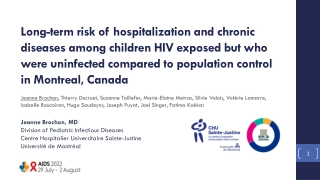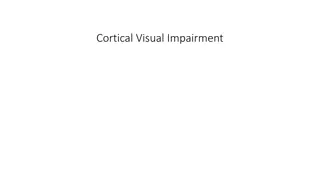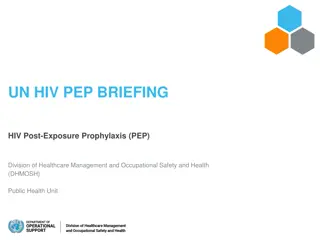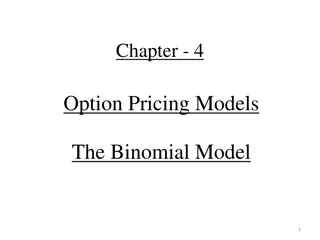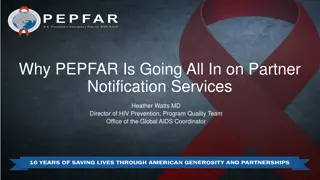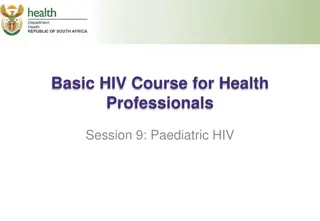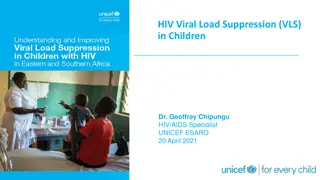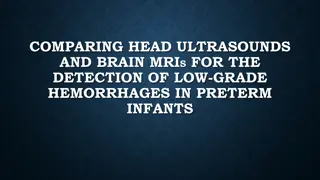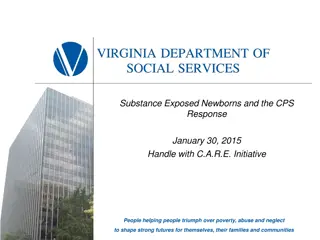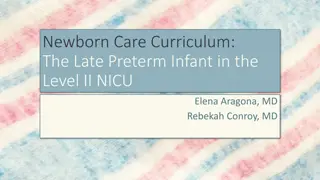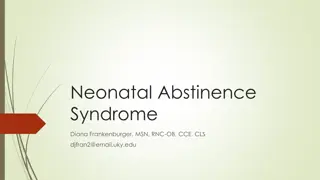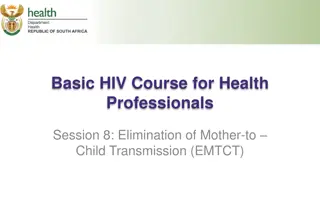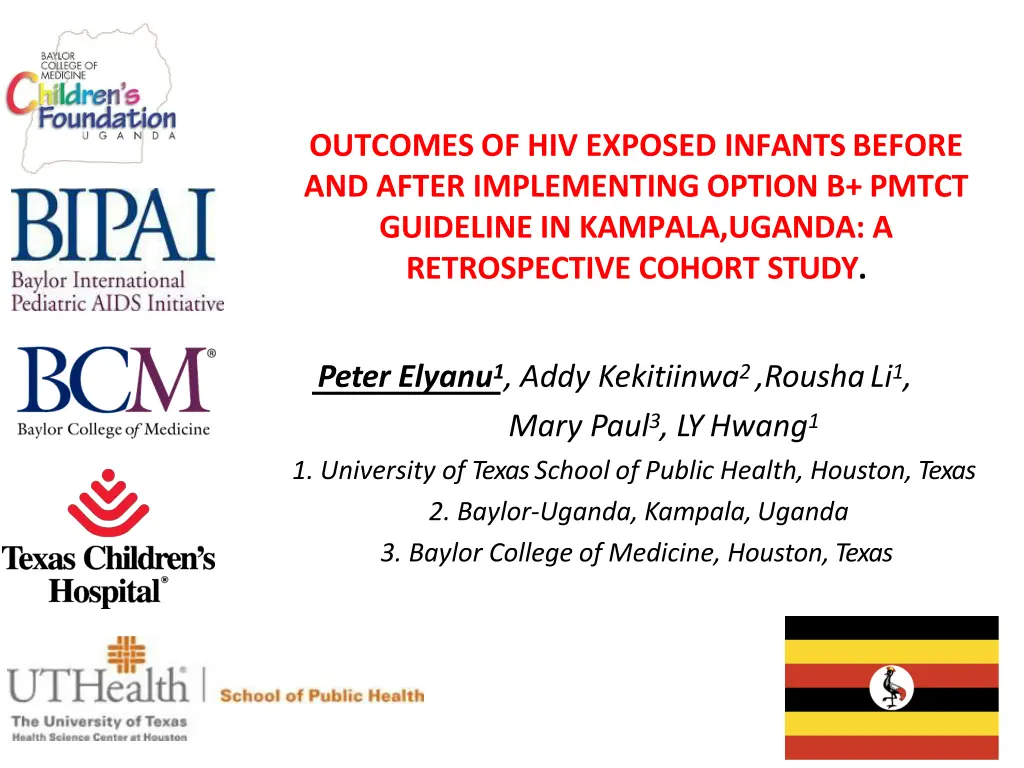
HIV Exposed Infant Outcomes in Uganda
This retrospective cohort study in Kampala, Uganda, evaluates the outcomes of HIV-exposed infants before and after implementing the Option B+ PMTCT guideline. The study compares MTCT rates, LTFU, mortality, cART initiation, and factors associated with MTCT. The impact of Option B+ guidelines on 18-month outcomes is assessed to measure the success of PMTCT interventions in preventing HIV transmission through breastfeeding and improving child survival.
Download Presentation

Please find below an Image/Link to download the presentation.
The content on the website is provided AS IS for your information and personal use only. It may not be sold, licensed, or shared on other websites without obtaining consent from the author. If you encounter any issues during the download, it is possible that the publisher has removed the file from their server.
You are allowed to download the files provided on this website for personal or commercial use, subject to the condition that they are used lawfully. All files are the property of their respective owners.
The content on the website is provided AS IS for your information and personal use only. It may not be sold, licensed, or shared on other websites without obtaining consent from the author.
E N D
Presentation Transcript
OUTCOMES OF HIV EXPOSED INFANTS BEFORE AND AFTER IMPLEMENTING OPTION B+ PMTCT GUIDELINE IN KAMPALA,UGANDA: A RETROSPECTIVE COHORT STUDY. Peter Elyanu1, Addy Kekitiinwa2 ,RoushaLi1, Mary Paul3, LYHwang1 1. University of Texas School of Public Health, Houston,Texas 2. Baylor-Uganda, Kampala,Uganda 3. Baylor College of Medicine, Houston,Texas
Background In 2012, WHO recommended providing lifelong ART to all HIV- infected pregnant and breastfeeding women, and ARV prophylaxis for their infant for six weeks (Option B+) as part of the strategy to eliminate MTCT. Reports show 6 week MTCT rates < 5% (Maria H Kim et al, 2015,Sebastian et at., 2015, Hierce et al 2015, William Bazeyo et al 2015) However, to date the impact of Option B+ guidelines on 18 month outcomes of HEI from programmatic settings is limited. And yet 18 months outcomes measure the success of PMTCT interventions at preventing HIV transmission through breastfeeding, and the impact of child survivalintervention.
Objectives 1. To compare HIV exposed infant outcomes (MTCT rate, LTFU and mortality) at 18 months of life, before and after implementing option B+ in Mulago Hospital, Kampala Uganda. 2. To compare cART initiation proportions in Infant who test HIV positive before and after implementing Option B+ in Mulago hospital, Uganda 3. To determine factors associated with MTCT after implementing Option B+ in Mulago hospital, Uganda.
Methods Study Design: Retrospective Cohort study Cohort definition: HIV exposed Infants born from; July 2010-June 2011 (Option A cohort) July 2013 to June 2014 (Option B+ cohort) Excluded those born from July 2011-June 2013 Reduce overlap between the 2 cohorts because of transition of the guidelines Study setting: Mulago Hospital postnatal clinic Data collection: Routinely collected patient-level data from the clinic s electronicdatabase.
Objective 1: To compare HIV exposed infant outcomes (MTCT rate, LTFU and mortality) before and after implementing option B+. Study Population: HEI aged <18 months. Attended the Mulago Hosp PNC clinic at least once afterbirth Received 1st HIV test at Mulago Hospclinic. Excluded: Transferred in s from otherclinics. Outcomes variables HIV infection , Loss to Follow up &Death
Outcomedefinition HIV infection: At least, one positive HIV DNA PCR test anytime during the follow-up period or a positive HIV rapid test at 18 months of age. LTFU: If there were three failed attempts to track the infant after the last clinic visit or if six months elapsed since the infant was last seen at the clinic. HIV Negative: Negative HIV DNA PCR test -done at least six weeks after cessation of breastfeeding or Negative HIV rapid test at 18 months of age. Transfer out: The infant transferred care to another health facility before any of the other events occurred.
Statistical analysis Survival analysis Compared 18 month cumulative incidence estimates of outcomes while accounting for competing risks. Outcome Time of origin Competing risk Censored event HIV infection Date of birth Death HIV negative Transfer out Loss to follow up Loss to follow Up Date of enrolment in care Date of Birth Death HIV infected HIV negative HIVnegative HIV infected Transfer out Death Transfer out Loss to followup
Objective 2: To compare ART initiation proportions of HIV+ Infant before and after implementing Option B+ Study Population: Infants who become HIV infected. We used Fisher s exact test to compare cART initiation proportions in HIV-infected infants in the two cohorts. Objective 3: Determine factors associated MTCT of HIV during Option B+ Proportional subdistribution hazard regression model for competing risks(Fine and Gray,1999) We used stepwise approach to select the most parsimonious model. Variables with p<0.2 at univariable analysis were considered for model selection.
RESULTS Baseline characteristics- Infants Option A Cohort N=2203 Option B+ cohort N=1571 Characteristic Median age in weeks at 1st PCR (IQR) 6.4(6.1,7.3) 6.3(6.0,6.7) Sex [n (%)] Male 1131 (51.3%) 788(50.2%) Median follow up months(IQR) Feeding option [n (%)] ARV s for PMTCT [n (%)] 9.6(3.1, 16.4) 1962(89.1%) 15.3(4.2, 16.5) 1447(92.2%) EBF Yes 2150(98.3%) 1542(98.5%) PMTCT ARV regimen Daily NVP up to 6 weeks 1113(50.9%) 1529(97.6%) Daily NVP through BF 897(41.0%) 13(0.8%) sdNVP 140(6.4%) 0(0.0%) None Yes Yes 36(1.7%) 214(10%) 162(7.7%) 22 (0.6%) Missing values 24(1.5%) 197(12.8%) 141(9.6%) Underweight [N (%)] Stunted [N (%)]
Mothers characteristics at childsenrolment Characteristic Option A CohortN=2203 Option B+ cohortN=1571 Mode of delivery [N (%)] Vaginal Delivery Caesarean section Place of delivery [N (%)] Health facility Home/TBA ARV s for PMTCT Yes No PMTCT regimen [N (%)] cART AZT+3TC, sdNVP AZT,sdNVP sdNVP None 22 (0.6%) Missing values; 8 (0.2%)missing values; cART Combination antiretroviral therapy. 1832(83.2%) 371(16.8%) 1282(81.6%) 289(18.4%) 2148(98.4%) 34(1.6%) 1545(98.4%) 25(1.6%) 2118(96.4%) 79(3.6%) 1517(96.7%) 52(3.3%) 1074(48.9%) 361(16.4%) 483(22.0%) 200(9.1%) 79(3.6%) 1508(96.1%) 9(0.6%) 0(0%) 0(0%) 52(3.3%)
18 month cumulative incidence of HIVinfection Gray s p-value=0.2 Option A 5.1% (95% CI:4.3,6.2%) Option B+ 4.3% (95% CI:3.3,5.5%) 6wks
18 month cumulative incidence of Loss to follow up Gray s p-value=0.06 Option A 30.3% (95% CI:28.4,32.3%) Option B+ 28.4% (95%:26.2,30.7%)
18 month cumulative incidence of mortality Gray s p-value=0.06 Option A 0.9% (95%CI:0.5,1.5%) Option B+ 1.4% (95%CI:0.8,2.2%)
Proportion of HIV infected infants initiated on cART before and after Option B+ p-value OptionA Cohort OptionB+ Characteristic N=97 cohortN=58 Initiated on ART [n (%)] Yes No 0.04 72(74.2%) 25(25.8%) 51(87.9%) 7(12.1%) Median age atHIV Diagnosis(months) 1.9(1.5,8.4) 3.7(1.5,8.1) 0.35 Median months from HIV diagnosis to cARTinitiation(IQR) 2.3(1.6,4.2) 0.6(0.4,0.8) <0.01
Factors associated with MTCT of HIV during option B+ Final Model Predictors Mother ARV s for PMTCTa Yes No Infant ARV s for PMTCTb Yes No Number %infected AdjustedHR 1517 2.2 46.2 Reference 16.3(7.6,34.6) <0.001 52 1542 2.8 14 Reference 2.5(1.03,4.95) 24 0.04 a 2 missing values; b5 missing values Other variables that were significant at univariable analysis but wereeliminated in the final model were; Infant feeding method, age at 1st PCR, place ofdelivery
Discussion We observed similar and low cumulative incidence of HIV infection Half of mothers in Option A cohort received cART The findings may be different from what lower level facilities with different implementation challenges may find. CI increased from 1% at 6 wks-4.3% at 18 month. MTCT rates observed at 6wks could double by 18 months(Ciaranello et al., 2011, Schmitz et al., 2013) Highlights the need for countries to report both 6 wk. and 18 months MTCT rates. LTFU is high in both cohorts despite robust follow up mechanisms. Referral centre, mother receive care apart from infants and clients may self transfer. Estimates of HIV and Mortality are susceptible to bias due to LTFU Sensitivity analysis: HIV infection Option B+ lower bound: 3.8% upper bound 31% Limitation: We studied infants who came for care after delivery. Our results could under-estimate outcomes.
Conclusion Outcomes of HIV-exposed infants at 18-months of life Pre and post Option B+ were similar; however, the cART initiation in HIV-infected infants was better during B+ implementation. Mothers or infants not receiving ARV spredicted MTCT during Option B+. LTFU remains high and should be addressed.

